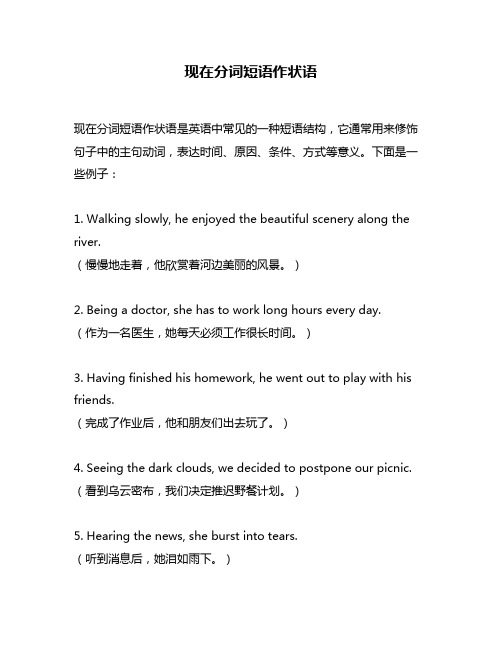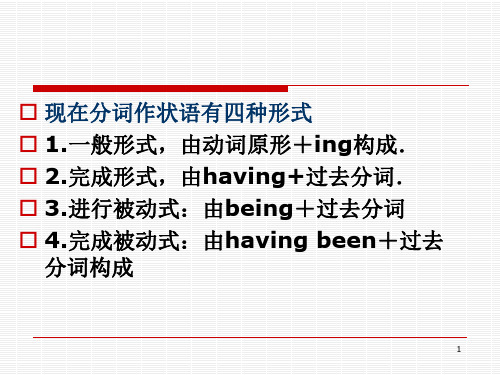现在分词短语作状语
现在分词短语作状语

现在分词短语作状语现在分词短语作状语是英语中常见的一种短语结构,它通常用来修饰句子中的主句动词,表达时间、原因、条件、方式等意义。
下面是一些例子:1. Walking slowly, he enjoyed the beautiful scenery along the river.(慢慢地走着,他欣赏着河边美丽的风景。
)2. Being a doctor, she has to work long hours every day.(作为一名医生,她每天必须工作很长时间。
)3. Having finished his homework, he went out to play with his friends.(完成了作业后,他和朋友们出去玩了。
)4. Seeing the dark clouds, we decided to postpone our picnic. (看到乌云密布,我们决定推迟野餐计划。
)5. Hearing the news, she burst into tears.(听到消息后,她泪如雨下。
)6. Knowing little about computers, he asked for help from his friend.(对电脑知之甚少,他向朋友求助。
)7. Feeling tired after a long day's work, she went straight to bed. (一天辛苦工作后感到疲惫不堪,她直接上床睡觉了。
)8. Hoping to win the game, they practiced hard every day.(希望赢得比赛,他们每天都刻苦练习。
)以上是一些常见的现在分词短语作状语的例子,它们都能够起到修饰句子、表达含义的作用。
在使用时需要注意语境和语法结构,避免出现歧义或错误。
现在分词短语的用法及例句

现在分词短语的用法及例句现在分词短语是英语中的一种非常常见的语法结构。
它通常由一个现在分词(-ing形式)和它所修饰的动词、名词或代词组成。
现在分词短语可以表示形容词、副词或介词短语的作用,用于修饰主语或谓语,并使句子更加生动、具有描述性和动态。
1. 现在分词作定语现在分词短语作为定语修饰名词或代词时,可以表示一个正在进行的动作或状态。
例句:- The running man is my brother.(奔跑的人是我的兄弟。
)- I saw the blushing girl in the hallway.(我在走廊上看到了脸红的女孩。
)- The singing birds woke me up this morning.(唱着歌的鸟儿今天早晨把我吵醒了。
)2. 现在分词作状语现在分词短语作为状语时,可以表示时间、原因、结果、方式等。
例句:- He watched TV all night, feeling bored.(他整晚都在看电视,感觉无聊。
)(表示原因)- Driving carefully, you can avoid accidents.(开车小心些,你就能避免事故。
)(表示方式)- Being a fluent speaker of English, he can communicate with anyone around the world.(他是一位英语流畅的演讲者,能够与世界各地的人沟通。
)(表示身份)例句:- I found the essay very interesting.(我觉得这篇文章非常有趣。
)- They kept the room clean and tidy.(他们保持房间的清洁整洁。
)现在分词短语可以用来表达各种各样的语法意义,在英语写作中非常常用。
熟练掌握现在分词短语的用法和性质,可以帮助我们更准确地表达自己的想法。
1. 现在分词作条件状语当现在分词短语与 if 或 when 连用时,可以表示一个条件或情况。
现在分词作状语有几种形式-有用

(4)表示结果
a. The old man died, leaving nothing but debts.
b. we hurried to school ,finding there were no students in the school.
c. They opened fire, killing one of our patrolmen.
2
Relying on our own efforts, we overcame all the difficulties.
They stood there for an hour ,watching the game.
Don’t just stand there doing nothing.
Judging from his accent, he seemed to be from Hunan province.
=If we judge…
29
Generally speaking, every spy has a contact.
Considering his age, he was helped by the young fellow.
23
注意2:分词作状语时,分词和 句子的主语一定要有逻辑上的主 谓关系
逻辑上的主谓关系即分词的动作 由句子的主语发出或承受.
24
We are sitting here, making notes. make的动作由主语我们 发出
Being scolded by his mother, the boy hung his head. Scold 的动作由the boy承受
27
He entering the office, a letter was found on the ground.
现在分词短语作状语

现在分词短语作状语一、时间状语1.分词动作一发生,谓语动作紧跟着发生,这时用现在分词的一般式作时间状语,其逻辑主语为句中的主语。
常用的动词,如:hear, see, arrive, return, get to, look, open, close, leave, turn around, walk等,表示一个极短暂动作。
此种情况能够换作on+动名词,表示相同的意思。
译作"一(刚)……就……"。
此种情况也能够换作是when引导的时间状语从句,该从句的动词多用一般过去时表示。
如:Hearing their teacher's voice, the pupils stopped talking at once.(= On hearing their teacher's voice… = When they heard their teacher's voice, the pupils…)一听到教师的声音,学生们立即停止讲话。
2.谓语动作发生在分词所表示的动作过程之中,则用when /while+现在分词的一般式,分词的逻辑主语为句中的主语。
此种情况能够用in+动名词的一般式代替。
也能够换作when、while引导的时间状语从句,该从句的谓语动词用实行时态。
如:Don't be careless when /while having an exam. = Don't be careless in having an exam. = Don't be careless when / while you are having an exam. 考试时不要粗心。
注:此结构中,不能用其他连接词替换when或while。
3.分词所表示的动作完成之后,谓语动作才发生,则要现在分词的完成式,即having done 的形式。
分词的逻辑主语应是句中的主语。
现在分词短语作状语要点总结

现在分词短语作状语要点总结现在分词作状语时,可表示时间、原因、条件、方式、伴随、结果、让步或补充说明等不同含义。
Coming into the room, he found the books. 他一进屋就找到了书。
(时间)Being ill, he didn’t attend the meeting. 因为病了,他没有参加会议。
(原因)Working hard, you will succeed. 如果你努力就会成功。
(条件)The girls went out of the room, laughing and talking, 姑娘们又说又笑地走出房间。
(伴随)He came here running. 他跑着来到这里。
(方式)At he age of three, his mother died, leaving him an orphan. 他三岁时丧母,成了孤儿。
(结果)She went away, walking south. 她离开了,向南方走去。
(补充说明)由以上例句可以看出,分词短语作状语时,若表示时间、条件或原因,通常要放在句首;表示伴随(也可放在句首)、方式、结果或补充说明的分词短语,通常要放在句尾。
现在分词作状语时要注意以下六个要点:1. 现在分词可以与when, while, if ,though等连词一起使用,使状语意义更加明确。
如:Be careful when crossing the street. 过马路要当心。
If falling ill, I’ll stay home taking a good rest. 如果生了病,我要在家好好休息。
Though not understanding French, they had a very good time in Paris this summer. 虽然他们不懂法语,但是,今年夏天他们在巴黎过得很愉快。
2. 现在分词作状语时,其逻辑主语通常应与句子主语保持一致,也就是说句子的主语应是现在分词动作的执行者。
现在分词作状语

4. Lots of rescue workers were working around the clock, _____ supplies to Yushu, Qinghai Province after the earthquake. (福建2010) A. sending B. to send C. having sent D. to have sent
Having been translated ______________________into many languages, the book was widely read all over the world. ( translate ) Having finished _____________his homework , he went to bed. ( finish )
T
Practice
单句改错
1. Having not seen the film, I can’t tell you what I think of it. Not having 2. The men worked for extra hours got an extra pay. working 3. Seen from the top of the hill, we find the city more beautiful. Seeing 4. Generally speak, facial expressions are helpful communications, too. speaking
5. “Can’t you read?” the man said, angrily pointed to the notice on the wall. pointing 6. Knocking at the door before entering, please. Knock 7. European football is played in 80 countries, made it the most popular sport in the world. making
现在分词作状语

常
见 •Lost in thought ,….
Compared with Shanghai,…. 分 Encouraged by his words,…. 词 Aborbed in a novel,…… Caught in the rain,…. Seated in the back,…. Seriously injured in the leg,…..
D
Practice :
3. _________ the last bus , he had to go home by taxi. A Not catching B Catching not C Having not caught D Not having caught
D
Practice :
4. ________ at night , the cry of the wolf made everyon ________. A Hearing … frightening B Hearing ….frightened C Heard…..frightening D Heard….frightened
doing/ done having done/ having been done
分词或分词短语作状语时, 时间, 分词或分词短语作状语时,可以表示时间, 原因,让步,条件, 原因,让步,条件,方式或伴随状语。 通常可以转换成相应的状语从句。
时间状语
When I saw the professor, I said hello to him.= Seeing _____________the professor , I said hello to him.= When _________ the professor, I said Seeing hello to him.
现在分词做作状语

现在分词做作状语分词作为状语是一种常见的用法,它可以修饰句子的主语、谓语、宾语或整个句子。
根据分词的形式和用法,可以分为以下几种情况:1. 现在分词作主语状语:现在分词可以单独作主语状语,表示伴随动作或状态。
例如:- Swimming is a good way to keep fit. (游泳是保持健康的好方法。
)- Running in the morning is refreshing. (早晨跑步很令人神清气爽。
)2. 现在分词作时间状语:现在分词可以表示时间状况,常用的有while, when, before, after等引导词。
例如:- While studying, he listened to music. (他一边学习,一边听音乐。
)- After finishing his homework, he went out for a walk. (做完作业后,他出去散步了。
)3. 现在分词作原因状语:现在分词可以表示原因或理由。
例如:- Being tired, she went to bed early. (她累了,所以早早上床睡觉了。
)- Having missed the bus, he had to walk home. (他错过了公交车,只能步行回家了。
)4. 现在分词作结果状语:现在分词可以表示结果,常用的情况有so, therefore等引导词。
例如:- He studied hard so as to pass the exam. (他努力学习,以便通过考试。
)- The weather was bad, so they stayed at home. (天气不好,所以他们呆在家里。
)。
- 1、下载文档前请自行甄别文档内容的完整性,平台不提供额外的编辑、内容补充、找答案等附加服务。
- 2、"仅部分预览"的文档,不可在线预览部分如存在完整性等问题,可反馈申请退款(可完整预览的文档不适用该条件!)。
- 3、如文档侵犯您的权益,请联系客服反馈,我们会尽快为您处理(人工客服工作时间:9:00-18:30)。
现在分词短语作状语
一、时间状语
1.分词动作一发生,谓语动作紧跟着发生,这时用现在分词的一般式作时间状语,其逻辑主语为句中的主语。
常用的动词,如:hear, see, arrive, return, get to, look, open, close, leave, turn around, walk等,表示一个极短暂动作。
此种情况可以换作on+动名词,表示相同的意思。
译作"一(刚)……就……"。
此种情况也可以换作是when引导的时间状语从句,该从句的动词多用一般过去时表
示。
如:Hearing their teacher's voice, the pupils stopped talking at once.(= On hearing their teacher's voice… = When they heard their teacher's voice, the pupils…)一听到教师的声音,学生们立即停止讲话。
2.谓语动作发生在分词所表示的动作过程之中,则用when /while+现在分词的一般式,分词的逻辑主语为句中的主语。
此种情况可以用in+动名词的一般式代替。
也可以换作when、while引导的时间状语从句,该从句的谓语动词用进行时态。
如:
Don't be careless when /while having an exam. = Don't be careless in having an exam. = Don't be careless when / while you are having an exam. 考试时不要粗心。
注:此结构中,不能用其他连接词替换when或while。
3.分词所表示的动作完成之后,谓语动作才发生,则要现在分词的完成式,即having done 的形式。
分词的逻辑主语应是句中的主语。
这种情况可以用after+动名词的一般式表示。
这种情况也可以用after /when引导的时间状语从句来替换,该从句的谓语动词用过去完成式。
如:Having finished his homework the boy was allowed to watch TV play.
After having finished his homework, the boy…
After /when he had finished his homework, the boy…
二、原因状语
1.分词短语在句中作原因状语时,相当于一个原因状语从句。
与时间状语一样,也要注意分词所表示的动作与谓语动作的先后关系。
当分词所表示的动作与谓语动作同时发生或几乎同时发生时,用分词的一般形式。
此时分词的逻辑主语须是句中的主语。
这样的原因状语可以换成because, as引导的原因状语,该从句谓语动词用一般过去时。
Not knowing how to work out the difficult physics problem, he asked the teacher for help. 因为不知道如何解这道物理难题,他求助老师。
= Because he didn't know how to work out the difficult physics problem, he asked…help.
2.当分词表示的动作发生在谓语动作之前,可以用现在分词的完成式在句中作原因状语,其逻辑主语须为句中的主语,该短语的作用相当于一个原因状语从句。
该从句的谓语动词须用完成时。
如:
Having lived with the girl for 5 years, we all know her very well.
= Because we have lived with the girl for 5 years, we all know her very well.因为与那个女孩一起生活了五年,我们都非常了解她。
三、条件状语
Working hard, you'll succeed. = If you work hard, you'll succeed. 如果你努力工作,你会成功的。
Turning to the left, you will find the path leading to the park.
= If you turn to the left, you will find the path leading to the park.如果转向左边,你将找到通向公园的小道。
四、让步状语
分词短语在句中作让步状语时,相当于一个让步状语从句,有时分词前可以带有连接词although, whether, even if, even though。
现在分词短语作让步状语,分词的逻辑主语是句中的主语,变成状语从句时,需用主动语态。
Weighing almost one hundred jin the stone was moved by him alone.
= Although the stone weighted almost one hundred jin, it was moved by him alone. 虽然那块石头重将近一百斤,他一个人就把它挪动了。
五、结果状语
现在分词短语在句中可以作结果状语,它的逻辑主语便是句中的主语,该短语相当于一个结果状语从句,且用主动语态。
分词短语在句中作结果状语时,通常位于句末,中间有逗号。
有时为了加强语气,就在分词前加thus。
Their car was caught in a traffic jam, thus causing the delay.
= Their car was caught in a traffic jam, thus it caused the delay. 他们的车遇上交通阻塞,因而耽误了。
六、方式或伴随状语
分词短语表示方式或伴随情况是比较常见的。
它用来说明动作发生的背景或情况。
一般情况下,现在分词所表示的动作与谓语所表示的动作同时发生,它的逻辑主语就是句中的主语,谓语动词作为主要动作,而现在分词表示一个陪衬动作,它没有相应的状语从句可以转换,但可以用并列句来转换。
过去分词可以说明谓语动作的背景。
过去分词与其逻辑主语之间有动宾关系。
如:
The children ran out of the room, laughing and talking merrily.
The children laughed and talked merrily, and they ran out of the room. 那些孩子们跑出房间,愉快地笑着、说着。
Helped by their teacher, the students finished the task successfully. 在老师的帮助下,学生们成功地完成了任务。
